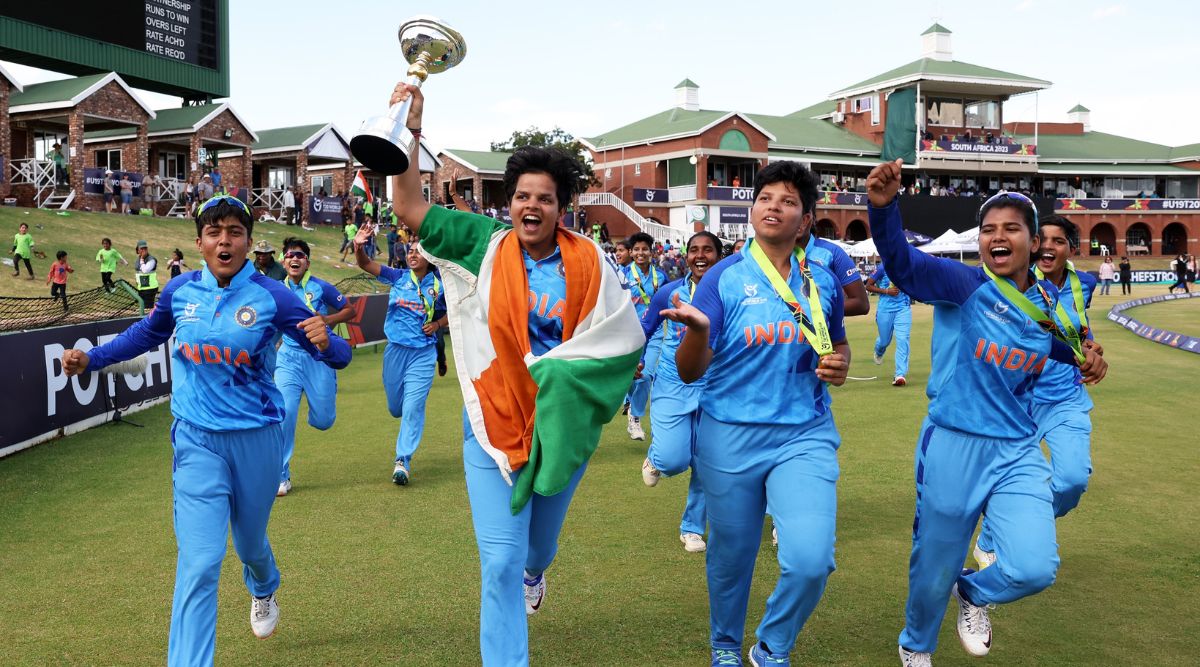
In the U-19 T20 World Cup final in Potchefstroom, South Africa, India defeated England by 7 wickets thanks to Soumya Tiwari’s frenzied effort to guide the ball past the point fielder.
She waved towards the changing area while halfway through her run while raising her arms. Her colleagues and support personnel surrounded her as she finished the run and fell to the ground, screaming, pounding their fists, crying, and praying. The pundits scurried around looking for a byte. But when they each wrote a line or two, they all gulped for breath, stuttered, and stammered.
We have been waiting for this moment for a very long time, and coach Nooshin Al Khadeer somehow managed to remark, “We have a very good future.” The team’s overwhelming and clinical defeat of England heralds a promising future for women’s cricket in the nation.
They were miles ahead of the competition in every aspect of the game. Titas Sadhu and Archana Devi, two new-ball bowlers, had England reeling at 16/3 by the end of the fourth over. England stumbled after being rattled by effective spin bowling on a sluggish surface, and they were eventually bowled out for a pitiful 68 in 17.1 overs.
Sadhu viciously swung the ball at right-handed batters, while Archana would tease them with her wacky off-breaks and delectable dip. Leg-spinner Parshavi Chopra tortured the English with her drift and turn. Her daily watch includes numerous of Shane Warne films. The stifling lengths vexed the left-arm spin twins Mannat Kashyap and Sonam Sharma. Even on the shaved, grassless portion of the ground used as practise wickets, the fielders would throw their bodies into the pitch. Trisha Gongadi, who amassed a significant 24 runs, and Archana both made two spectacular catches that would have made some of South Africa’s most illustrious fielders happy.
More than simply defeating their rivals on the field was the key to these gifted young women’s triumph. They were forced to fight several, multi-layered fights off the field over the years. They had experienced rejection, prejudice, adversity financially, and gender stereotypes. Therein may be found a greater victory.
In Archana’s hometown of Unnao, her mother received criticism for leading her daughter down the “galat rasta” (wrong path). But her mother, who became the family’s main provider after her husband passed away from cancer in 2008, and brother supported her wholeheartedly throughout her cricketing career.
Sona Yadav’s father, a labourer at a glass factory in Firozabad, did not have the money to support his daughter’s love of the game, but he put in extra hours to try to wring out some money so she could purchase a cricket outfit and shoes.
Coach Suresh Chainani turned down vice-captain Saumya Tiwari because he refused to train female athletes at his Bhopal academy after a few of them left. But before we returned to the academy and persuaded Sir to train her, Saumya cried nonstop for two days.
He concurred,” says her father Manish Tiwari, a Bhopal Collectorate election supervisor. He would play with paper balls and a wooden stick that was used to wash clothes before she enrolled in the academy. Similar to this, lower-order hitter Hrishita Basu, whose style she has modelled after her idol MS Dhoni, was forced to wait all day in the heat because she lacked the Rs 20 the coach had required to be paid in order to bat. It is also a story about parents being sacrificed.4th batter Trisha’s father left his position as a gym instructor in Badrachalam to move to Hyderabad in order to enrol the family’s aspiring cricketer at a cricket academy. The father of wicket-keeper Richa Ghosh, a former club cricket player in Siliguri, would spend hours in the backyard teaching her daughter throw-downs so she might fulfil his unfulfilled ambition of wearing India colours. In Patiala, the father of the spinner Kashyap looked everywhere for a coach because no one would hire a women.
It marks the end of a long journey filled with sweat, tears, hope, and determination for the athletes, parents, family members, and coaches. But after one adventure is over, another one starts. Some of them would become millionaires in a few weeks at the Women’s Indian Premier League’s first player auction. The WIPL has the potential to revolutionise women’s cricket, and no generation of cricketers would gain as much from it financially and professionally as the U-19 World Cup-winning team of 2023.
The influence and scope might be comparable to Virat Kohli’s team from the 2008 U-19 World Cup champions. The majority won the auction shortly after their victory and instantly became millionaires; some even got famous and became household names. Shafali and her gang may be referred to as “the WPL generation” in the same way that the league’s poster boys, “the IPL generation,” are.
Women’s cricket has been freed from the shackles of mediocrity over the past five years. India has reached the semifinals and finals of the last two senior T20 World Cups. But this evening in Potchefstroom, Soumya may have made the most significant run in not only her own life but also the history of women’s cricket in South Africa, as well as that of her colleagues.


